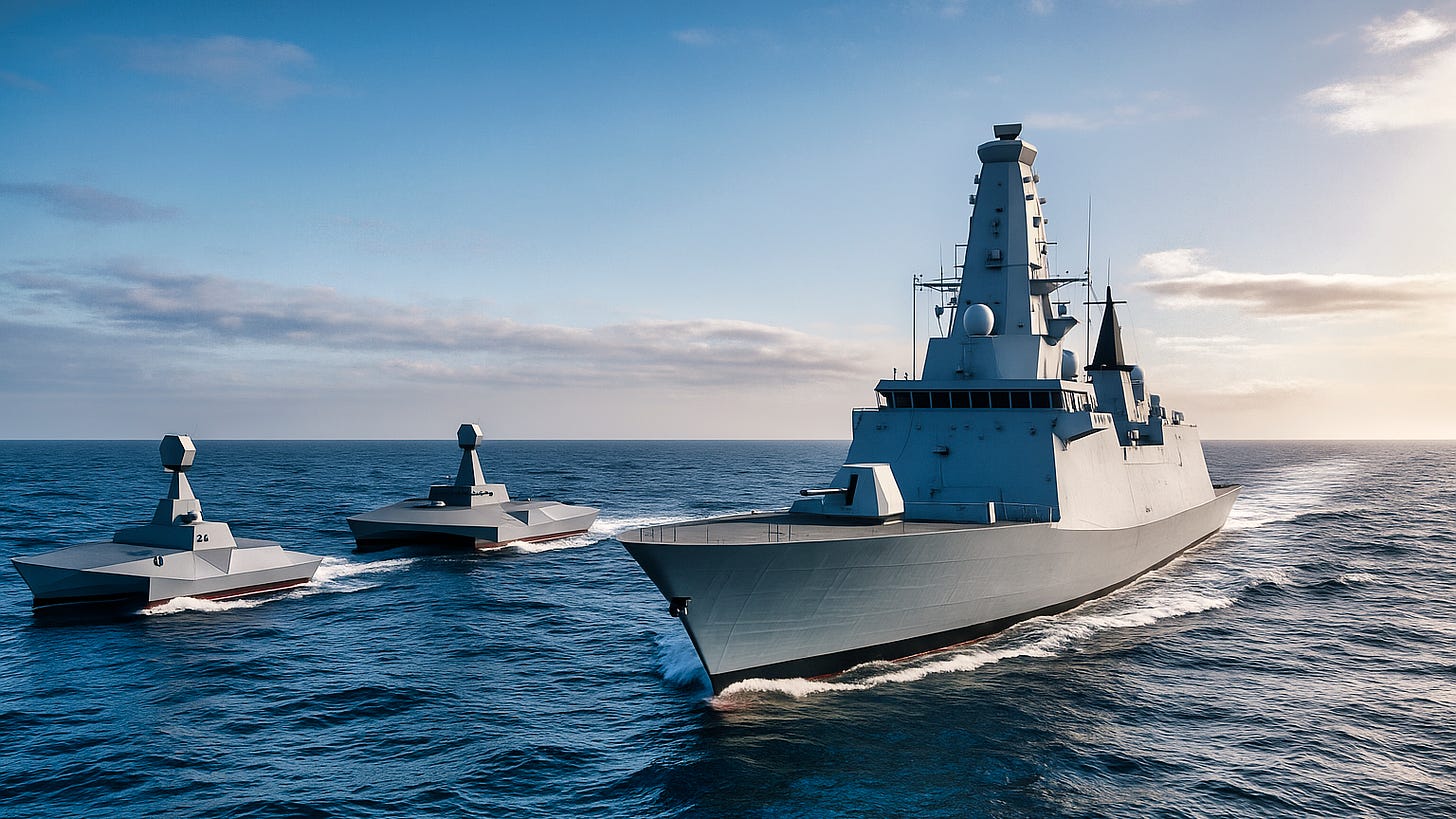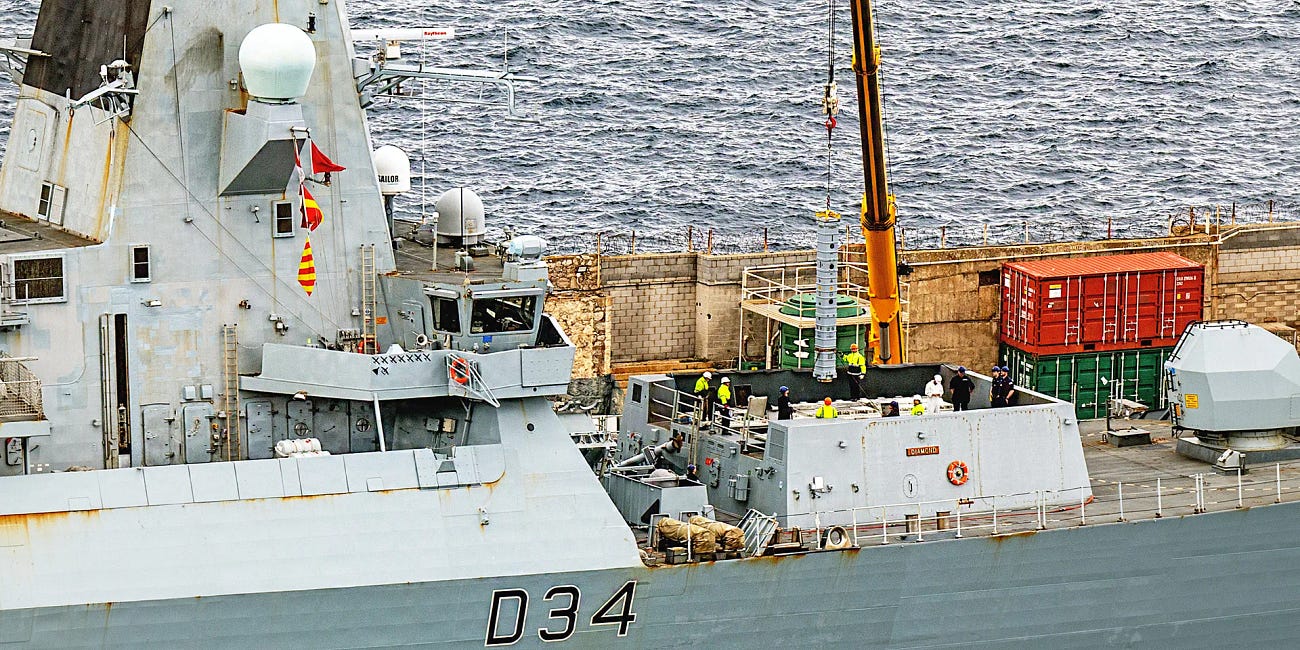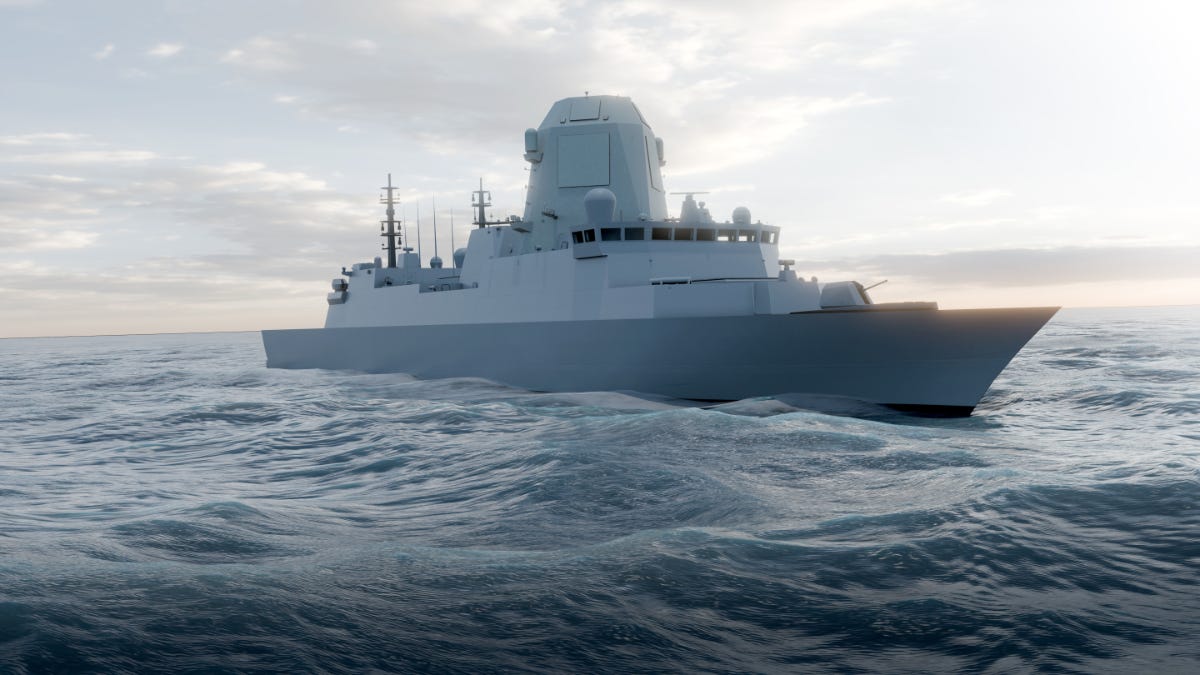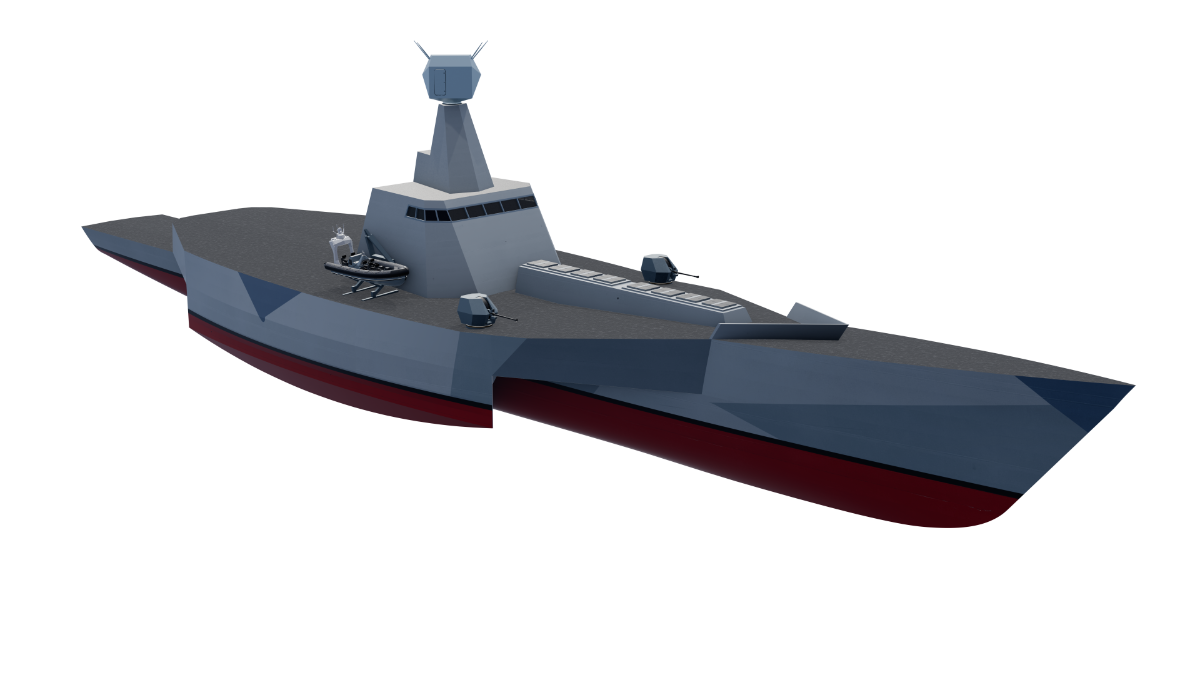The AI Shipmate
Part 1 – Strategy, FADS, and the Rise of the Loyal Escort
In September 2025, the First Sea Lord of the Royal Navy announced a bold plan at DSEI: the RN’s newest frigates will soon sail with uncrewed “loyal escort” ships at their side. These AI-enabled consorts are envisioned as force multipliers, carrying extra missiles, sensors, and decoys, to enhance the lethality and survivability of crewed warships.
This represents a profound shift in naval doctrine. Instead of relying solely on a few exquisite, manned platforms for combat power, the Royal Navy is pivoting to a “system-of-systems” approach, where manned warships operate as the core of a distributed network of autonomous assets.
This first article in The AI Shipmate series examines the strategic rationale behind this shift, situating it within the Royal Navy’s Vision 2040, the Future Air Dominance System (FADS) programme, and the 2025 Strategic Defence Review. We will explore how the “loyal wingman” concept is being applied at sea, the early steps to integrate uncrewed escorts (with the Type 31 frigate as a testbed), and the digital combat systems enabling this vision.
We conclude by outlining the industrial and doctrinal challenges that must be addressed for the RN’s AI shipmates to become reality – setting the stage for Part 2, which will delve into uncrewed ship survivability, damage control, and subsea networks.
Strategic Context: Vision 2040 and the Shift to System-of-Systems
The Royal Navy’s embrace of uncrewed escorts is driven by a broad strategic reorientation, articulated in RN Vision 2040 and the UK’s latest defence strategy documents. At the Combined Naval Event 2025, Vice Admiral Paul Marshall described the Royal Navy of the future as “uncrewed where possible, crewed where needed,” leveraging autonomy for mass and AI to handle the “speed and complexity” of modern warfare. This vision underpins a move away from single-platform lethality toward distributed, networked combat power.
Within the naval domain, the Future Air Dominance System (FADS) concept exemplifies this ethos. FADS, led by Commodore Michael Wood, is envisaged as a maritime Integrated Air and Missile Defence (IAMD) solution built around the future Type 83 destroyer – but crucially, not limited to a single hull. It is “characterised as an interoperable, multidomain system-of-systems”, integrating sensors, effectors, and platforms, potentially including “missile barges or USV loyal wingmen.”
The First Sea Lord’s September 2025 announcement can thus be seen as an early manifestation of RN Vision 2040 and FADS principles. Jenkins made it explicit that the RN must be “uncrewed wherever possible, crewed only where necessary”, a strategy to generate mass at scale without waiting for traditional long-cycle warship builds. The Type 26 frigate and its unmanned escorts are a pilot case for how the Royal Navy intends to fight going forward.
The Loyal Wingman Concept at Sea: Uncrewed Escorts for Type 26
When HMS Glasgow (the first Type 26 City-class frigate) eventually deploys, she “will not be alone,” as First Sea Lord Jenkins declared. He described a Type 26 sailing in company with two uncrewed escorts – essentially loyal wingman drone ships – “using AI to work in tandem with the warship.”
These escorts will:
Act as missile barges, expanding the frigate’s limited VLS arsenal, an issue we have already discussed here:
Beyond the First Salvo
·Despite the advances in naval missile systems over the past four decades, a fundamental limitation remains unaddressed: most modern warships are still designed to fire once and then withdraw.
Operate as sensor nodes, extending radar and sonar coverage.
Serve as AI-managed effectors, deploying decoys, jammers, or their own weapons.
In effect, they transform one frigate into a three-ship distributed unit, providing mass, reach, and resilience without additional crew. Jenkins set a near-term goal: first uncrewed escorts by 2027.
Type 31 as a Testbed for Uncrewed Integration
If Type 26 is the high-end mothership, the Type 31 “Inspiration-class” frigate will be the proving ground:
119 m² Mission Bay (6 TEU modules) for modular payloads.
Four boat bays for RHIBs or USVs.
Chinook-capable flight deck and Merlin hangar for UAVs.
TACTICOS CMS is designed for open, app-driven integration.
The Type 31’s modularity and combat system make it the RN’s live laboratory at sea for uncrewed integration, de-risking loyal escort operations before scaling to Type 26.
Combat Systems Foundation: TACTICOS and the Digital Backbone
The glue that binds manned and unmanned together is the combat management system (CMS). Thales TACTICOS, fitted to Type 31, is:
Open-architecture, using DDS middleware for real-time data sharing.
App-driven, allowing new functions (like USV control) to be added quickly.
Operator-focused, reducing complexity by fusing offboard and onboard data.
TACTICOS provides the digital backbone for networked TEWA loops – enabling Type 26 and its escorts to fight as one.
DSEI Insight: Industry Moves to Match the RN
At DSEI 2025, BAE Systems briefed its programme “Designing and delivering naval ships of the future.” The language was strikingly aligned with the First Sea Lord’s call: modern navies must generate combat mass under tighter budgets and shrinking crews, while embracing autonomy and AI.
BAE highlighted three areas of direct relevance:
Type 26 as command hub – now described as a “battlespace integration hub” for hosting and fusing uncrewed systems.
CMS modernisation – under the RECODE programme, BAE is converting its CMS into an app-based, open architecture battlespace system, enabling rapid autonomy integration.
Future concepts – two new designs:
a Future Air Warfare Command Ship, hosting main sensors, CMS, and effectors;
a trimaran Deployed Sensor/Effector Platform, ultra-lean crewed or autonomous, operating as a forward picket with self-defence.
This is the industry’s direct answer to the First Sea Lord’s demand for operational uncrewed escorts within two years.
Perhaps most revealing was BAE’s acknowledgement that lean crewing is as much cultural as technical. As Gavin Rudgley put it, success requires “a cultural change in the way ships are operated.” At DSEI, you could see the friction: Type 31’s machinery plant can be entirely run from the bridge like a merchant ship, yet senior RN navigators remain uneasy.
The First Sea Lord’s challenge is therefore not only procurement, it is persuading his own leadership cadre to trust automation where it already works.
Industrial & Strategic Risks: Enabling the AI Escort Fleet
The plan hinges on:
British-first industrial model, ensuring sovereignty and pace.
Procurement reform, shifting to spiral development and contractor-operated prototypes.
Trust in AI, putting machines in the loop where speed and complexity demand it.
Funding and political will to sustain momentum through the SDR 2025 cycle.
Conclusion & Next Steps
The Royal Navy’s vision of AI shipmates – uncrewed escorts loyal to their crewed frigates- is rapidly moving from concept to reality. Strategically, it reflects a world where no single warship is survivable alone. Doctrinally, it marks a shift back to task-group thinking, with machines filling roles once held by additional crewed vessels. Technologically, it relies on open combat systems and autonomy.
In Part 2, we’ll turn to the harder edge: survivability, damage control, and subsea integration. Because fighting with AI shipmates isn’t just about sailing together, it’s about keeping the formation alive when the shooting starts.
Sources & Further Reading
Combined Naval Event 2025 – RN Transformation & FADS
UK Naval leadership statements on autonomy, mass, and “uncrewed where possible, crewed where needed.”
Combined Naval Event 2025 Insights Report (Navy Leaders)Naval Damage Control 2025 – Lean Manning & Autonomy
Special feature: “Damage Control on Lean-Manned and Autonomous Platforms.” Key insights on sensor trust, cultural friction, and redefining survivability.
Naval Damage Control Feature, 2025 (BAE Systems/industry briefing)Type 31 General Arrangement
Royal Navy design notes: 119m² mission bay (6×TEU), four boat bays, Chinook-capable deck, Merlin hangar, and TACTICOS CMS fit.
Royal Navy Type 31 GA (Navy Lookout coverage)TACTICOS Combat Management System
Thales CMS architecture brief: DDS middleware, app-based integration, and modular workflow.
Thales TACTICOS Combat Management SystemBAE Systems – Exploiting the Underwater Battlespace
Analysis of ISR, ASW, and critical undersea infrastructure protection, with emphasis on next-gen subsea networking.
BAE Systems Digital Intelligence White Paper, July 2025BAE DSEI 2025 Media Brief
“Designing and delivering naval ships of the future” – unveiling Future Air Warfare Command Ship and Deployed Sensor/Effector Platform concepts.
BAE Systems Maritime, DSEI 2025






